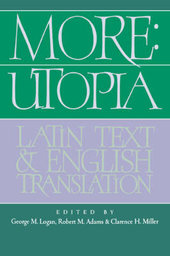
|
More: Utopia: Latin Text and English Translation
Paperback / softback
Main Details
| Title |
More: Utopia: Latin Text and English Translation
|
| Authors and Contributors |
By (author) Thomas More
|
|
Edited by George M. Logan
|
|
Edited by Robert M. Adams
|
|
Edited by Clarence H. Miller
|
| Physical Properties |
| Format:Paperback / softback | | Pages:340 | | Dimensions(mm): Height 228,Width 152 |
|
| ISBN/Barcode |
9780521024976
|
| Classifications | Dewey:321.07 |
|---|
| Audience | | Professional & Vocational | |
|---|
| Illustrations |
Worked examples or Exercises
|
|
Publishing Details |
| Publisher |
Cambridge University Press
|
| Imprint |
Cambridge University Press
|
| Publication Date |
16 March 2006 |
| Publication Country |
United Kingdom
|
Description
First published in Latin in 1516, Thomas More's Utopia is one of the most influential books in the Western philosophical and literary tradition and one of the supreme achievements of Renaissance humanism. This is the first edition of Utopia since 1965 (the Yale edition) to combine More's Latin text with an English translation, and also the first edition to provide a Latin text that is both accurate and readable. The text is based on the early editions (with the Froben edition of March 1518 as copy-text), but spelling and punctuation have been regularized in accordance with modern practices. The translation is a revised version of the acclaimed lively and readable Adams translation, which also appears in Cambridge Texts in the History of Political Thought. This edition, which incorporates the results of recent Utopian scholarship, also includes an introduction, textual apparatus, a full commentary and a guide to the voluminous scholarly and critical literature on Utopia.
Reviews"There is much to commend in this Latin/English edition of More's Renaissance masterwork...this edition can be recommended for undergraduate students." The Sixteenth Century Journal "There is much to commend in this Latin/English edition of More's Renaissance masterwork...this edition can be recommended for graduate students." R.J. Schoeck, The Sixteenth century Journal
|